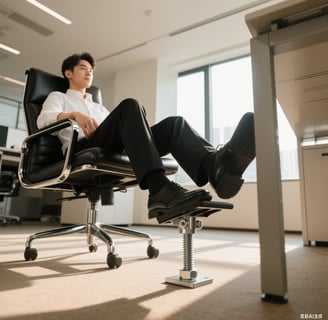Fuzhou Victor Furniture Co., Ltd.
Enhancing Comfort: The Role of Adjustable Screws in Footrests
6/9/20257 min read


Introduction to Footrests and Their Importance
Footrests are a fundamental component in the design of various types of furniture and equipment, particularly in enhancing user comfort and support. Their primary purpose lies in promoting proper posture and reducing strain on the body during extended periods of sitting. Footrests are not only pivotal in office environments but also play a critical role in home settings where comfort is a priority.
In the context of office chairs, footrests contribute significantly to ergonomic design, allowing users to adjust their leg position and maintain a neutral posture while working. This aids in alleviating back pain, lower limb discomfort, and overall fatigue associated with prolonged sitting. Additionally, footrests can be found in public seating arrangements, such as in cinemas and airports, where they enhance the overall user experience by providing added relaxation during waiting or leisure periods.
Moreover, footrests are commonly integrated into couches and recliners, offering additional support to ensure that users can stretch their legs comfortably. This is especially relevant for individuals recovering from injuries or those with mobility challenges, as adjustable designs can offer the necessary height and tilt modifications. In various contexts—from workspaces to leisure areas—the use of footrests significantly increases comfort, catering to diverse needs and preferences.
The functionality of footrests can be further enhanced by incorporating adjustable screws. Such features allow users to customize the height and angle of the footrest according to their specific needs, thus maximizing comfort and support. Understanding the importance of footrests and their design elements, including adjustable screws, sets the stage for a deeper exploration of how these components contribute to an improved sitting experience.
Understanding Adjustable Screws: Function and Benefits
Adjustable screws are integral components that play a critical role in the engineering of footrests. These screws allow for height and angle adjustments, accommodating the varying needs of users for optimal comfort and ergonomics. By enabling effortless modification, adjustable screws contribute significantly to the customization of footrests, ensuring that they can be tailored to individual preferences.
One of the primary benefits of adjustable screws is their ability to enhance stability. When a footrest is properly adjusted, it provides reliable support to the feet and legs, preventing discomfort during prolonged use. This increased stability not only fosters a more comfortable seating position but also promotes proper posture. As users' knees and hips are aligned correctly, the likelihood of strain and injury is considerably reduced.
Moreover, the ease of use associated with adjustable screws cannot be overlooked. Typically designed with user-friendly mechanisms, these screws enable simple adjustments without the need for specialized tools. This feature is particularly advantageous in dynamic environments, such as workplaces where multiple individuals may need to use the same footrest. Quick adjustments ensure users can find their ideal position swiftly, thus enhancing their overall experience.
Incorporating adjustable screws into the design of footrests is not merely about functionality; it is about improving the user experience as a whole. These screws facilitate a more personalized approach to comfort, allowing individuals to modify their footrests according to their unique body dimensions and working conditions. Ultimately, adjustable screws contribute to the evolution of footrest design, promoting better health, increased productivity, and an overall more satisfying use. As such, they represent a vital component in enhancing comfort for users across various settings.
The Customization Factor: Height Adjustability
Height adjustability plays a crucial role in enhancing the comfort of footrests, particularly for individuals with varying leg lengths and personal preferences. The implementation of adjustable screws allows users to easily tailor their footrests to meet their specific needs, providing greater flexibility in terms of ergonomics and usability. By accommodating these differences, adjustable footrests enable enhanced support, which can lead to a more comfortable seating experience overall.
For instance, consider an office environment where some employees may be taller than others. Without adjustable footrests, those who are taller may find that their feet dangle, creating discomfort and strain over time, while shorter individuals may have to stretch to reach their footrests. By incorporating adjustable screws, facilities are able to provide various height options, granting each employee the opportunity to personalize their workstation, thus promoting well-being and productivity.
Practical examples can be found in case studies showcasing the implementation of adjustable footrests in ergonomics-focused workplaces. In one study involving a corporate office, employees reported significant reductions in discomfort after being provided with footrests that could be adjusted. The feature enabled them to find the optimal height for their feet, ultimately reducing lower back pain and improving overall posture. Such testimonials highlight the direct correlation between customizable features in footrests and the comfort they provide, underscoring the importance of adjustable screws.
Moreover, the ability to modify footrest height is beneficial not merely in static environments such as offices but also in dynamic settings such as home use. Families with multiple members, each with different body types, can benefit immensely; adjustable screws allow each person to configure their footrest, facilitating an enhanced level of comfort regardless of the user’s stature.
Impact on Ergonomics and User Health
The use of adjustable footrests featuring screws plays a crucial role in enhancing ergonomics, significantly impacting user health and comfort. In professional and recreational settings, individuals often sit for extended periods, which can lead to various musculoskeletal disorders. Improper foot positioning can result in strain on the legs, back, and even the neck. Adjustable footrests that utilize screws allow users to achieve optimal foot positioning, promoting proper alignment of the body.
When the feet are positioned correctly, there is a reduction in pressure on the thighs and lower back, which helps alleviate discomfort. This is critical for those working in office environments, where sedentary behavior is prevalent. Poorly positioned feet can create an imbalance, leading to muscle fatigue and pain over time. By utilizing adjustable screws, users can customize the height and angle of their footrests to suit their unique body dimensions, effectively improving their sitting posture.
Moreover, proper ergonomics facilitated by adjustable footrests can significantly contribute to overall well-being. Studies have shown that maintaining a comfortable and correctly aligned position can increase productivity and focus, as it reduces distractions caused by discomfort. Additionally, regular adjustments using screws encourage users to be mindful of their posture, promoting active engagement in their workspace. This not only supports physical health but also enhances mental clarity and efficiency.
In essence, the incorporation of adjustable footrests with screws addresses more than just comfort; it fosters a healthier work environment. By enabling users to find the ideal position for their feet, these devices help prevent long-term health issues, such as chronic pain and repetitive strain injuries. Therefore, investing in adjustable footrests is an essential component of ergonomically sound workspace design.
Versatility in Various Furniture Designs
Adjustable screws in footrests play a significant role in enhancing the versatility of furniture designs, accommodating a range of styles and functions. As furniture continues to evolve, designers increasingly incorporate the ability to adjust elements like footrests to meet the unique needs of different users. This adaptability is particularly beneficial to both residential and commercial environments, enabling furniture to be tailored for comfort and functionality.
The integration of adjustable screws allows footrests to suit a diverse array of seating arrangements, making them compatible with various chair styles, from traditional to modern designs. In offices, for instance, ergonomic chairs equipped with adjustable footrests promote better posture and reduce discomfort during prolonged periods of sitting. The same principles apply to living spaces, where footrests can be utilized with recliners, sofas, or lounge chairs, enabling users to customize their seating experience substantially.
In recent years, trends in furniture design reflect a growing emphasis on multifunctionality. Designers are now creating pieces that are not only aesthetically appealing but also adaptable to various activities, such as working, relaxing, or entertaining. The inclusion of adjustable screws in footrests enhances this trend by providing flexibility, allowing users to modify their furniture according to their specific preferences. As a result, these adjustable elements contribute to a more personalized experience, appealing to an increasingly diverse consumer base.
Overall, the adaptability of adjustable screws in footrests serves to improve the usability of furniture across multiple settings. Whether it’s a home office, a cozy living room, or a chic café, these versatile components help optimize comfort and ensure that every piece of furniture can cater to the demands of modern living.
Practical Tips for Choosing Adjustable Footrests
When it comes to enhancing comfort during work or leisure, selecting an adjustable footrest with screws can significantly contribute to your overall ergonomic setup. Here are some practical tips to consider when making your selection.
Firstly, pay close attention to the materials used in the construction of the footrest. Durable materials such as high-quality plastic or metal alloys not only ensure longevity but also enhance stability. A footrest made from sturdy materials can withstand regular adjustments and maintain structural integrity over time, which is crucial for those who intend to use it frequently.
Another vital criterion to evaluate is the range of adjustability. An ideal footrest should offer a wide range of height and angle adjustments. This feature allows users to customize the footrest to their specific needs, which is essential given the varying preferences and leg lengths of individuals. Additionally, a larger adjustment range can accommodate different seating arrangements, making the footrest versatile for various setups.
Stability is also a significant factor when choosing adjustable footrests. Look for models that incorporate anti-slip features or wider bases to ensure that the footrest remains secure during use. This stability is particularly important for users who may shift positions frequently, as it prevents unintentional slipping or movement during adjustment.
Lastly, ease of adjustment should not be overlooked. Select a model that offers simple mechanisms for adjusting the height and angle of the footrest, ideally one that does not require excessive effort or tools. Features such as quick-release levers or intuitive screw adjustments can significantly enhance usability. By focusing on these factors, you can find an adjustable footrest that meets your comfort needs and contributes to better posture, thereby enhancing your overall comfort.
Future Innovations in Footrest Design
As we examine the future innovations in footrest design, it becomes evident that advancements in adjustable screws will play a pivotal role in enhancing user comfort and functionality. Increasingly, manufacturers are recognizing the importance of ergonomic solutions that not only accommodate various body types but also adapt to the specific needs of individual users. This evolution is likely to be driven by a combination of technological integration and innovative materials.
One of the promising trends in footrest design is the incorporation of smart technology. Adjustable screws in future models may be equipped with pressure sensors and connectivity features, allowing users to customize their settings via smartphone applications. This level of personalization could empower users to adjust their footrests based on real-time feedback regarding posture and comfort, thus promoting better health outcomes.
Moreover, materials used in footrest construction are likely to undergo significant transformation. Future footrests may utilize lightweight composites that not only enhance durability but also reduce the environmental impact of production. The integration of sustainable materials could resonate well with a growing consumer preference for eco-friendly products, further increasing their marketability.
In addition, the unceasing pursuit for compact and multifunctional designs will likely lead to innovations where adjustable screws are not merely a feature, but serve several functions. For instance, footrests could potentially incorporate storage into their design without compromising their ergonomic purpose. Such versatility would cater to diverse user needs and fit seamlessly into various work environments.
In summary, the future of adjustable screws in footrests is positioned to embrace technological advancements and innovative materials, thereby enhancing user experience. As we look ahead, it is clear that these innovations will not only elevate comfort levels but also redefine the overall functionality of footrests in diverse settings.
